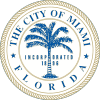Miami metropolitan area
Miami metropolitan area
Miami–Fort Lauderdale–West Palm Beach, FL Metropolitan Statistical Area[1] | |
|---|---|
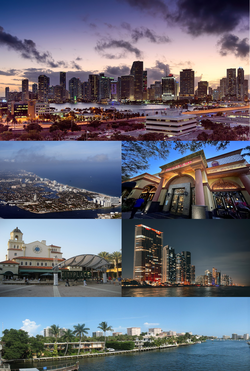 From top (left to right):Greater Downtown Miami,Fort Lauderdale,Sawgrass Mills,The SquareatWest Palm Beach,Miami Beach,andBoca Raton | |
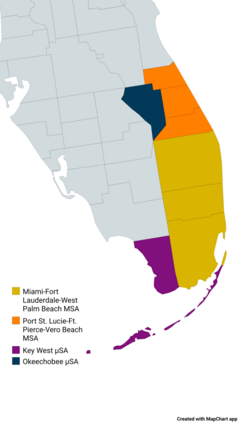 Location of the Miami metropolitan area's four primary components inFlorida | |
| Coordinates:26°8′N80°12′W/ 26.133°N 80.200°W | |
| Country | |
| State | |
| Core city | |
| Principal cities[1] | |
| Area | |
| • Land | 6,137 sq mi (15,890 km2) |
| Highest elevation | Jupiter 53 ft (16.2 m) |
| Lowest elevation | Atlantic Ocean 0 ft (0 m) |
| Population | |
| • Total | 6,138,333 |
| • Estimate (2023)[3] | 6,183,199 |
| • Rank | 9thin the United States 1stin Florida |
| • Density | 1,000.38/sq mi (386.37/km2) |
| GDP | |
| • MSA | $483.755 billion (2022) |
| Time zone | UTC−05:00(Eastern Standard Time) |
| • Summer (DST) | UTC−04:00(Eastern Daylight Time) |
TheMiami metropolitan area,also known asSouth Florida,SoFlo,SoFla,[citation needed]the Gold Coast,the Tri-County Area,orGreater Miami,and officially theMiami–Fort Lauderdale–West Palm Beach Metropolitan Statistical Area,is a coastalmetropolitan areain southeasternFlorida.It is the ninth-largestmetropolitan statistical area(MSA) in the United States, the fifth-largest metropolitan area in theSouthern United States,and the largest metropolitan area in Florida. With a population of 6.18 million,[3]its population exceeds31 of the nation's 50 statesas of 2023. It comprisesthe three most populated counties in the state,Miami-Dade County,Broward County,andPalm Beach County,which rank as the first, second, and third-most populous counties in the state, respectively. Miami-Dade County, with 2,701,767 people in 2020, is theseventh-most populous county in the United States.
Miamiis the region's financial and cultural core and most populous city. Otherprincipal cities,as defined by theOffice of Management and Budget,includeFort Lauderdale,West Palm Beach,Pompano Beach,Boca Raton,Sunrise,Deerfield Beach,Miami Beach,Kendall,Doral,Delray Beach,Jupiter,andPalm Beach Gardens.[1]The Miami metropolitan area is part of the largerSouth Floridaregion of the state, which also includes theEvergladesand theFlorida Keys.
With 1,279.2 sq mi (3,313 km2) ofurban landmass,the Miami metropolitan area also is one of theworld's most populousurban agglomerations.
South Florida is largely confined to a strip of land between theAtlantic OceanandEverglades,and Miami's urbanized area is about 100 miles (160 km) long (north to south) and at most 20 miles (32 km) east to west; in some areas, its east to west width is only 5 miles (8 km). The Miami metropolitan statistical area is the second-longest urbanized area in the United States behind theNew York metropolitan area.[5]It was the eighth-most densely populated urbanized area in the United States as of the 2000 census.[6]
As of the 2020 census, the Miami-Fort Lauderdale urbanized area had a land area of 1,244.18 square miles (3,222.4 km2), with a population of 6,077,522, for apopulation densityof 4,884.78 inhabitants per square mile (1,886.02/km2). The Miami metropolitan area also had oneurban cluster(UC) as of the 2020 census, which is not part of the Miami urbanized area. The Belle Glade urban cluster had a population of 23,009, area of 7.21 square miles (18.7 km2) and population density of 3,191.41 inhabitants per square mile (1,232.21/km2).[7]Miami, the largest city in the metropolitan area, had population density of over 10,000/sq mi (more than 3,800/km2) in 2000.[8][9]The Miami Urbanized Area was the fourth-largest urbanized area in the United States in the 2010 census.
The most notable colleges and universities in the Miami metropolitan area includeFlorida Atlantic University,Florida International University,Nova Southeastern University,and theUniversity of Miami.The region also has three community colleges,Broward College,Miami Dade College,andPalm Beach State College.Some of these institutions, such as Florida International University and Miami Dade College, make up some of the largest institutions of higher learning in the United States.[10]
Definitions
[edit]Miami metropolitan area
[edit]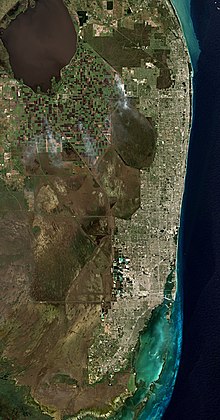
As of 2023[update],the Miami metropolitan area is defined by the U.S.Office of Management and Budgetas theMiami-Fort Lauderdale-West Palm BeachMetropolitan Statistical Area (MSA),[1]with a 2020 population of 6,138,333. The MSA is made up of three "metropolitan divisions":
- Miami-Miami Beach-KendallMetropolitan Division, coterminous withMiami Dade County(2020 population 2,701,767).
- Fort Lauderdale-Pompano Beach-SunriseMetropolitan Division, coterminous withBroward County(2020 population 1,944,375).
- West Palm Beach-Boca Raton-Delray BeachMetropolitan Division, coterminous withPalm Beach County(2020 population 1,492,191).[11]
The MSA is the second most populous metropolitan area in theSoutheastern United Statesand has an area of 6,137 sq. mi (15,890 km2).
The original MSA for Miami, as defined by the OMB, included only Dade County (now Miami-Dade County). By 1995, the Miami-Hialeah and Fort Lauderdale-Hollywood-Pompano Beach MSAs had been merged into the Miami-Fort Lauderdale Consolidated MSA, consisting of the Miami Primary MSA (Dade County) and the Fort Lauderdale Primary MSA (Broward County).[12]In 2003, the West Palm Beach-Boca Raton-Boynton Beach MSA was merged with the consolidated MSA to form the Miami-Fort Lauderdale-Miami Beach Metropolitan Statistical Area, consisting of: the Fort Lauderdale-Pompano Beach-Deefield Beach Metropolitan Division (Broward County), the Miami-Miami Beach-Kendall Metropolitan Division (Miami-Dade County), and the West Palm Beach-Boca Raton-Boynton Beach Metropolitan Division (Palm Beach County).[13]
Miami-Port Saint Lucie-Fort Lauderdale Combined Statistical Area
[edit]The Census Bureau also defines a wider commercial region based on commuting patterns, theMiami-Port Saint Lucie-Fort LauderdaleCombined Statistical Area (CSA), with a population of 6,887,655 in 2020.
As of 2023[update],the CSA consists of three component metropolitan statistical areas (MSAs) and oneMicropolitan statistical area(μSA):
- TheMiami-Fort Lauderdale-West Palm BeachMSA (2020 pop. 6,138,333)
- ThePort Saint LucieMSA (2020 pop. 486,660), consisting of:
- Martin County(2020 pop. 158,431)p. 28
- Saint Lucie County(2020 pop. 329,226)p. 28
- TheSebastian-Vero Beach-West Vero CorridorMSA, coterminous withIndian River County(2020 pop. 159,788)
- TheKey West-Key LargoμSA, coterminous withMonroe County(2020 pop. 82,874).
- TheOkeechobeeμSA, coterminous withOkeechobee County.[14][11]
When the CSA was defined in 2013, it included the Okeechobee μSA, but not the Key West μSA. In 2018 the Okeechobee μSA was removed from the CSA and the Key West μSA was added. The Okeechobee μSA was re-added to the CSA in 2023.[15][16][14]
Gold Coast
[edit]The Miami metropolitan area is frequently named the "Gold Coast" in convention withFlorida's other coast regions,including theSpace Coast,Treasure Coast,Sun Coast,Nature Coast,Forgotten Coast,Emerald Coast,Fun Coast,andFirst Coast.Like several of the others, it seems to have originated at the time the area first saw major growth. One of the best known of Florida's vernacular regions, the name is a reference to the wealth and ritzy tropical lifestyle that characterizes the area.[17][18]
Climate and geography
[edit]Climate
[edit]
South Florida/Miami metropolitan area has atropical climate,similar to the climate found in much of theCaribbean.It is the only metropolitan area in the48 contiguous statesthat falls under that category. More specifically, it generally has atropical monsoon climate(Köppen climate classification,Am).[19]The South Florida metropolis sees most of its rain in the summer (wet season) and is quite dry in the winter (dry season). The wet season, which is hot and humid, lasts from May to October, when daily thunderstorms and passing weak tropical lows bring downpours during the late afternoon. The dry season often starts in late October and runs through late April. During the height of the dry season from February through April, South Florida is often very dry, and often brush fires and water restrictions are an issue. At times cold fronts can make it all the way down to South Florida and provide some modest rainfall in the dry season. Thehurricane seasonlargely coincides with the wet season.[20]
In addition to its sea-level elevation, coastal location and position near theTropic of Cancerandthe Caribbean,the area owes its warm, humid climate to theGulf Stream,which moderates climate year-round. A typical summer day does not see temperatures below 75 °F (24 °C). Temperatures in the high 80s to low 90s (30–35 °C) accompanied by high humidity are often relieved by afternoonthunderstormsor asea breezethat develops off the Atlantic Ocean, which then allow lower temperatures, although conditions still remain very muggy.
During winter, dry air often dominates as dew points are often very low. Average daily high temperatures across South Florida during the winter are around 74–77 °F (23–25 °C). Although daily highs can sometimes reach 82–85 °F (28–29 °C) even in January and February. Daily low temperatures during the winter are generally around 55–63 °F (13–17 °C). Each winter, cold fronts occasionally make their way down to the northernBahamasandSouth Florida.As a result, daytime high temperatures in South Florida may only reach around 65 °F (18 °C) or cooler. When this occurs low temperatures can dip into the 40s during the early morning hours before quickly warming-up toward late morning/early afternoon. It is rare for temperatures to drop below 40 °F (4 °C), however, low temperatures at or around 35 °F (2 °C) have occurred some years. South Florida only experiences these cold spells about twice each winter and they typically only last a day or two before temperatures return to the mid 70s. On average South Florida is frost-free, although there can be a light frost in the inland communities about once every decade.
Hurricane seasonofficially runs from June 1 through November 30, although hurricanes can develop outside that period. The most likely time for South Florida to be hit is during the peak of theCape Verdeseason, mid-August through the end of September.[21]Due to its location between two major bodies of water known for tropical activity, South Florida is also statistically the most likely major area to be struck by a hurricane in the world, trailed closely byNassau, Bahamas,andHavana,Cuba. Many hurricanes have affected the metropolis, includingBetsyin 1965,Andrewin 1992,Irenein 1999, HurricanesKatrinaandWilmain 2005, andIrmain 2017. In addition, a tropical depression in October 2000 passed over the city, causing record rainfall and flooding. Locally, the storm is credited as theNo Name Storm of 2000,though the depression went on to become Tropical Storm Leslie upon entering the Atlantic Ocean.
| Climate data forWest Palm Beach Airport,Florida (1981–2010 normals,[22]extremes 1888–present) | |||||||||||||
|---|---|---|---|---|---|---|---|---|---|---|---|---|---|
| Month | Jan | Feb | Mar | Apr | May | Jun | Jul | Aug | Sep | Oct | Nov | Dec | Year |
| Mean daily maximum °F (°C) | 75.2 (24.0) |
76.3 (24.6) |
80.0 (26.7) |
84.1 (28.9) |
87.0 (30.6) |
90.7 (32.6) |
92.0 (33.3) |
91.3 (32.9) |
88.3 (31.3) |
84.3 (29.1) |
82.3 (27.9) |
76.7 (24.8) |
84.3 (29.1) |
| Mean daily minimum °F (°C) | 57.4 (14.1) |
58.6 (14.8) |
61.7 (16.5) |
65.0 (18.3) |
71.1 (21.7) |
75.0 (23.9) |
75.2 (24.0) |
75.4 (24.1) |
74.3 (23.5) |
70.9 (21.6) |
63.4 (17.4) |
60.0 (15.6) |
66.8 (19.3) |
| Average rainfall inches (mm) | 2.18 (55) |
2.09 (53) |
2.05 (52) |
2.03 (52) |
5.76 (146) |
9.02 (229) |
9.27 (235) |
9.83 (250) |
9.93 (252) |
9.57 (243) |
5.07 (129) |
2.27 (58) |
60.35 (1,533) |
| Average rainy days(≥ 0.01 in) | 7.8 | 6.7 | 5.0 | 5.8 | 14.1 | 16.0 | 18.1 | 19.0 | 16.7 | 17.1 | 10.2 | 7.1 | 132.6 |
| Source: NOAA[23][24] | |||||||||||||
| Climate data forFort Lauderdale Int'l Airport,Florida (1981–2010 normals, extremes 1912–present) | |||||||||||||
|---|---|---|---|---|---|---|---|---|---|---|---|---|---|
| Month | Jan | Feb | Mar | Apr | May | Jun | Jul | Aug | Sep | Oct | Nov | Dec | Year |
| Mean daily maximum °F (°C) | 75.5 (24.2) |
76.7 (24.8) |
78.5 (25.8) |
82.9 (28.3) |
85.6 (29.8) |
89.8 (32.1) |
91.9 (33.3) |
90.5 (32.5) |
88.8 (31.6) |
85.8 (29.9) |
81.0 (27.2) |
76.9 (24.9) |
83.3 (28.5) |
| Mean daily minimum °F (°C) | 59.0 (15.0) |
60.5 (15.8) |
63.4 (17.4) |
66.9 (19.4) |
72.0 (22.2) |
74.4 (23.6) |
75.9 (24.4) |
75.8 (24.3) |
75.2 (24.0) |
71.8 (22.1) |
65.7 (18.7) |
61.3 (16.3) |
67.7 (19.8) |
| Average rainfall inches (mm) | 3.63 (92) |
2.96 (75) |
3.36 (85) |
2.89 (73) |
4.65 (118) |
10.16 (258) |
5.98 (152) |
7.44 (189) |
8.59 (218) |
6.82 (173) |
3.24 (82) |
2.46 (62) |
62.18 (1,579) |
| Average rainy days(≥ 0.01 in) | 5.0 | 6.1 | 6.9 | 5.4 | 8.8 | 15.9 | 15.9 | 15.7 | 15.8 | 10.6 | 8.1 | 8.1 | 122.3 |
| Source:[25][26][27] | |||||||||||||
| Month | Jan | Feb | Mar | Apr | May | Jun | Jul | Aug | Sep | Oct | Nov | Dec | Year |
|---|---|---|---|---|---|---|---|---|---|---|---|---|---|
| Record high °F (°C) | 88 (31) |
89 (32) |
93 (34) |
97 (36) |
98 (37) |
98 (37) |
100 (38) |
98 (37) |
97 (36) |
95 (35) |
91 (33) |
89 (32) |
100 (38) |
| Mean maximum °F (°C) | 84.4 (29.1) |
85.8 (29.9) |
89.0 (31.7) |
90.7 (32.6) |
92.8 (33.8) |
94.2 (34.6) |
94.7 (34.8) |
94.5 (34.7) |
93.2 (34.0) |
90.9 (32.7) |
87.0 (30.6) |
84.9 (29.4) |
95.8 (35.4) |
| Mean daily maximum °F (°C) | 76.2 (24.6) |
78.2 (25.7) |
80.6 (27.0) |
83.6 (28.7) |
86.7 (30.4) |
89.3 (31.8) |
90.6 (32.6) |
90.7 (32.6) |
89.0 (31.7) |
85.9 (29.9) |
81.3 (27.4) |
78.2 (25.7) |
84.2 (29.0) |
| Daily mean °F (°C) | 68.6 (20.3) |
70.7 (21.5) |
73.1 (22.8) |
76.7 (24.8) |
80.1 (26.7) |
82.8 (28.2) |
84.1 (28.9) |
84.2 (29.0) |
83.0 (28.3) |
80.1 (26.7) |
74.8 (23.8) |
71.2 (21.8) |
77.4 (25.2) |
| Mean daily minimum °F (°C) | 61.0 (16.1) |
63.2 (17.3) |
65.6 (18.7) |
69.8 (21.0) |
73.4 (23.0) |
76.3 (24.6) |
77.5 (25.3) |
77.7 (25.4) |
76.9 (24.9) |
74.2 (23.4) |
68.3 (20.2) |
64.3 (17.9) |
70.7 (21.5) |
| Mean minimum °F (°C) | 45.1 (7.3) |
48.5 (9.2) |
52.3 (11.3) |
59.6 (15.3) |
66.7 (19.3) |
71.5 (21.9) |
72.5 (22.5) |
72.8 (22.7) |
72.7 (22.6) |
65.0 (18.3) |
55.7 (13.2) |
49.7 (9.8) |
42.5 (5.8) |
| Record low °F (°C) | 28 (−2) |
27 (−3) |
32 (0) |
39 (4) |
50 (10) |
60 (16) |
66 (19) |
67 (19) |
62 (17) |
45 (7) |
36 (2) |
30 (−1) |
27 (−3) |
| Averageprecipitationinches (mm) | 1.83 (46) |
2.15 (55) |
2.46 (62) |
3.36 (85) |
6.32 (161) |
10.51 (267) |
7.36 (187) |
9.58 (243) |
10.22 (260) |
7.65 (194) |
3.53 (90) |
2.44 (62) |
67.41 (1,712) |
| Average precipitation days(≥ 0.01 in) | 7.7 | 6.5 | 6.3 | 6.9 | 10.8 | 17.6 | 17.3 | 19.4 | 18.1 | 13.8 | 8.6 | 8.0 | 141.0 |
| Averagerelative humidity(%) | 72.7 | 70.9 | 69.5 | 67.3 | 71.6 | 76.2 | 74.8 | 76.2 | 77.8 | 74.9 | 73.8 | 72.5 | 73.2 |
| Averagedew point°F (°C) | 57.6 (14.2) |
57.6 (14.2) |
60.4 (15.8) |
62.6 (17.0) |
67.6 (19.8) |
72.0 (22.2) |
73.0 (22.8) |
73.8 (23.2) |
73.2 (22.9) |
68.7 (20.4) |
63.9 (17.7) |
59.2 (15.1) |
65.8 (18.8) |
| Mean monthlysunshine hours | 219.8 | 216.9 | 277.2 | 293.8 | 301.3 | 288.7 | 308.7 | 288.3 | 262.2 | 260.2 | 220.8 | 216.1 | 3,154 |
| Percentpossible sunshine | 66 | 69 | 75 | 77 | 72 | 70 | 73 | 71 | 71 | 73 | 68 | 66 | 71 |
| Averageultraviolet index | 5.1 | 6.7 | 8.6 | 10.2 | 10.5 | 10.7 | 10.8 | 10.5 | 9.3 | 7.1 | 5.3 | 4.5 | 8.2 |
| Source 1: NOAA (relative humidity, dew point and sun 1961–1990),[28][29][30]The Weather Channel[31] | |||||||||||||
| Source 2: UV Index Today (1995 to 2022),[32]Thunderstorm days (1961 to 1990)[33] | |||||||||||||
| Climate data forMiami Beach,1981−2010 normals | |||||||||||||
|---|---|---|---|---|---|---|---|---|---|---|---|---|---|
| Month | Jan | Feb | Mar | Apr | May | Jun | Jul | Aug | Sep | Oct | Nov | Dec | Year |
| Mean daily maximum °F (°C) | 73.8 (23.2) |
74.9 (23.8) |
76.3 (24.6) |
79.4 (26.3) |
82.8 (28.2) |
86.5 (30.3) |
88.1 (31.2) |
88.5 (31.4) |
87.0 (30.6) |
83.7 (28.7) |
79.3 (26.3) |
75.7 (24.3) |
81.3 (27.4) |
| Mean daily minimum °F (°C) | 61.4 (16.3) |
63.0 (17.2) |
65.3 (18.5) |
69.2 (20.7) |
73.9 (23.3) |
77.0 (25.0) |
78.3 (25.7) |
78.6 (25.9) |
77.7 (25.4) |
74.7 (23.7) |
69.5 (20.8) |
64.3 (17.9) |
71.1 (21.7) |
| Average rainfall inches (mm) | 2.09 (53) |
2.33 (59) |
3.00 (76) |
3.20 (81) |
4.98 (126) |
8.27 (210) |
4.35 (110) |
6.37 (162) |
7.88 (200) |
4.47 (114) |
2.74 (70) |
2.05 (52) |
51.73 (1,313) |
| Average rainy days(≥ 0.01 in) | 6.7 | 6.0 | 6.9 | 6.0 | 8.9 | 14.5 | 12.1 | 14.0 | 14.9 | 11.2 | 8.1 | 6.9 | 116.2 |
| Source: NOAA (extremes 1927−present)[28] | |||||||||||||
Component counties, subregions, and cities
[edit]Largest cities
[edit]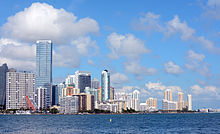
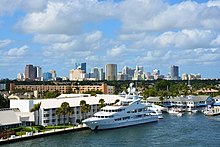
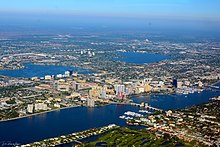
The following is a list of the twenty largest cities in the Miami metropolitan area as ranked by population.[34][35][36]
| City | County | 2000 population |
2010 population |
2020 population |
2010 to 2020 % change |
|---|---|---|---|---|---|
| Miami | Miami-Dade | 362,470 | 399,457 | 442,241 | +10.71% |
| Hialeah | Miami-Dade | 226,419 | 224,669 | 223,109 | −0.69% |
| Fort Lauderdale | Broward | 152,397 | 165,521 | 182,760 | +10.41% |
| Pembroke Pines | Broward | 137,427 | 154,750 | 171,178 | +10.62% |
| Hollywood | Broward | 139,357 | 140,768 | 153,067 | +8.74% |
| Miramar | Broward | 72,739 | 122,041 | 134,721 | +10.39% |
| Coral Springs | Broward | 117,549 | 121,096 | 133,394 | +10.16% |
| Miami Gardens | Miami-Dade | 100,758 | 107,167 | 111,640 | +4.17% |
| Pompano Beach | Broward | 78,191 | 99,845 | 112,046 | +12.22% |
| West Palm Beach | Palm Beach | 82,103 | 99,919 | 117,415 | +17.51% |
| Davie | Broward | 75,720 | 91,922 | 105,691 | +14.98% |
| Boca Raton | Palm Beach | 74,764 | 84,392 | 97,422 | +15.44% |
| Sunrise | Broward | 85,779 | 84,439 | 97,335 | +15.27% |
| Plantation | Broward | 82,934 | 84,955 | 91,750 | +8.00% |
| Miami Beach | Miami-Dade | 87,933 | 87,779 | 82,890 | −5.57% |
| Deerfield Beach | Broward | 64,583 | 75,018 | 86,859 | +15.78% |
| Boynton Beach | Palm Beach | 60,389 | 68,217 | 80,380 | +17.83% |
| Lauderhill | Broward | 57,585 | 66,887 | 74,482 | +11.35% |
| Doral | Miami-Dade | 20,438 | 45,704 | 75,874 | +66.01% |
| Homestead | Miami-Dade | 31,909 | 60,512 | 80,737 | +33.42% |
Areas with between 10,000 and 100,000 inhabitants
[edit]- Aventura
- Belle Glade
- Boca Del Mar
- Boynton Beach
- Brownsville
- Coconut Creek
- Cooper City
- Coral Gables
- Coral Terrace
- Country Club
- Country Walk
- Cutler Bay
- Dania Beach
- Deerfield Beach
- Delray Beach
- Doral
- Florida City
- Fontainebleau
- Gladeview
- Glenvar Heights
- Goulds
- Greenacres
- Hallandale Beach
- Hamptons at Boca Raton
- Hialeah Gardens
- Homestead
- Ives Estates
- Jupiter
- Kendale Lakes
- Kendall West
- Kendall
- Key Biscayne
- Kings Point
- Lake Worth Corridor
- Lake Worth Beach
- Lauderdale Lakes
- Lauderhill
- Leisure City
- Lighthouse Point
- Margate
- Miami Beach
- Miami Lakes
- Miami Shores
- Miami Springs
- North Lauderdale
- North Miami Beach
- North Miami
- North Palm Beach
- Oakland Park
- Ojus
- Olympia Heights
- Opa-locka
- Palm Beach Gardens
- Palm Beach
- Palm Springs
- Palmetto Bay
- Palmetto Estates
- Parkland
- Pinecrest
- Pinewood
- Plantation
- Princeton
- Richmond West
- Riviera Beach
- Royal Palm Beach
- Sandalfoot Cove
- South Miami Heights
- South Miami
- Sunny Isles Beach
- Sunrise
- Sunset
- Sweetwater
- Tamarac
- Tamiami
- The Crossings
- The Hammocks
- University Park
- Wellington
- West Little River
- West Park
- Westchester
- Weston
- Westwood Lakes
- Wilton Manors
Areas with fewer than 10,000 inhabitants
[edit]- Atlantis
- Bal Harbour
- Bay Harbor Islands
- Belle Glade Camp
- Biscayne Park
- Boca Pointe
- Boulevard Gardens
- Briny Breezes
- Broadview Park
- Canal Point
- Century Village
- Cypress Lakes
- Dunes Road
- El Portal
- Fisher Island
- Franklin Park
- Fremd Village-Padgett Island
- Glen Ridge
- Godfrey Road
- Golden Beach
- Golden Lakes
- Golf
- Gulf Stream
- Gun Club Estates
- Haverhill
- High Point
- Highland Beach
- Hillsboro Beach
- Hillsboro Pines
- Homestead Base
- Hypoluxo
- Indian Creek
- Islandia
- Juno Beach
- Juno Ridge
- Jupiter Inlet Colony
- Lake Belvedere Estates
- Lake Clarke Shores
- Lake Harbor
- Lake Park
- Lakeside Green
- Lantana
- Lauderdale-by-the-Sea
- Lazy Lake
- Limestone Creek
- Manalapan
- Mangonia Park
- Medley
- Mission Bay
- Naranja
- North Bay Village
- Ocean Ridge
- Pahokee
- Palm Beach Shores
- Palm Springs North
- Pembroke Park
- Plantation Mobile Home Park
- Richmond Heights
- Roosevelt Gardens
- Royal Palm Estates
- Schall Circle
- Sea Ranch Lakes
- Seminole Manor
- South Bay
- South Palm Beach
- Southwest Ranches
- Stacy Street
- Surfside
- Tequesta
- Three Lakes
- Villages of Oriole
- Virginia Gardens
- Washington Park
- Westlake
- West Miami
- West Perrine
- Westview
- Whisper Walk
Demographics
[edit]| Census | Pop. | Note | %± |
|---|---|---|---|
| 1920 | 66,542 | — | |
| 1930 | 214,830 | 222.8% | |
| 1940 | 387,522 | 80.4% | |
| 1950 | 693,705 | 79.0% | |
| 1960 | 1,497,099 | 115.8% | |
| 1970 | 2,236,885 | 49.4% | |
| 1980 | 3,220,844 | 44.0% | |
| 1990 | 4,056,100 | 25.9% | |
| 2000 | 5,007,564 | 23.5% | |
| 2010 | 5,564,635 | 11.1% | |
| 2020 | 6,138,333 | 10.3% | |
| 2023 (est.) | 6,183,199 | 0.7% | |
| U.S. Decennial Census 1920–1970[37]1980[38]1990[39] 2000[40]2010[41]2020[2]2023[3] | |||
| Historical racial composition | 2020[2] | 2010[41] | 2000[40] | 1990[39] | 1980[38] |
|---|---|---|---|---|---|
| White(non-Hispanic) | 29.1% | 34.8% | 44.1% | 54.5% | 64.6% |
| Hispanic or Latino | 45.9% | 41.6% | 34.0% | 27.8% | 20.2% |
| Black or African American(non-Hispanic) | 18.7% | 19.7% | 18.1% | 16.3% | 14.2% |
| AsianandPacific Islander(non-Hispanic) | 2.6% | 2.2% | 1.7% | 1.2% | 1.1% |
| Native American(non-Hispanic) | 0.1% | 0.1% | 0.1% | 0.1% | |
| Other Race (non-Hispanic) | 0.8% | 0.3% | 0.3% | 0.1% | |
| Two or more races(non-Hispanic) | 2.8% | 1.2% | 1.8% | N/A | N/A |
| Population | 6,138,333 | 5,564,635 | 5,007,564 | 4,056,100 | 3,220,844 |
| Demographic characteristics | 2020[42][43][44] | 2010[45][46][47] | 2000[48][49][50] | 1990[39] | 1980[38][51] |
|---|---|---|---|---|---|
| Households | 2,641,002 | 2,464,417 | 2,149,749 | 1,586,355 | 1,261,686 |
| Persons per household | 2.32 | 2.26 | 2.33 | 2.56 | 2.55 |
| Sex Ratio | 92.8 | 93.8 | 93.4 | 92.1 | 90.1 |
| Ages 0–17 | 19.6% | 21.7% | 23.6% | 22.0% | 22.6% |
| Ages 18–64 | 61.5% | 62.4% | 59.9% | 59.7% | 59.3% |
| Ages 65 + | 18.9% | 15.9% | 16.4% | 18.3% | 18.1% |
| Median age | 42.2 | 39.9 | 37.7 | 36.4 | 36.9 |
| Population | 6,138,333 | 5,564,635 | 5,007,564 | 4,056,100 | 3,220,844 |
| Economic indicators | |||
|---|---|---|---|
| 2017–21American Community Survey | Miami metro area | Florida | |
| Median income[52] | $34,644 | $34,367 | |
| Median household income[53] | $62,855 | $61,777 | |
| Poverty Rate[54] | 13.6% | 13.1% | |
| High school diploma[55] | 86.5% | 89.0% | |
| Bachelor's degree[55] | 34.1% | 31.5% | |
| Advanced degree[55] | 13.0% | 11.7% | |
| Language spoken at home[c] | 2015[d] | 2010[e] | 2000[58] | 1990[59] | 1980[60] |
|---|---|---|---|---|---|
| English | 46.9% | 49.2% | 55.3% | 64.0% | 72.9% |
| SpanishorSpanish Creole | 41.6% | 39.7% | 34.6% | 27.8% | 20.2% |
| FrenchorHaitian Creole | 5.9% | 5.8% | 4.9% | 3.0% | 1.3% |
| Other Languages | 5.5% | 5.3% | 5.3% | 5.1% | 5.7% |
| Nativity | 2015[f] | 2010[g] | 2000[65][66] | 1990[59] | 1980[60] |
|---|---|---|---|---|---|
| % populationnative-born | 60.0% | 61.8% | 65.0% | 71.0% | 76.7% |
| ... born in theUnited States | 57.0% | 59.1% | 62.3% | 68.4% | 75.0% |
| ... born inPuerto RicoorIsland Areas | 1.8% | 1.7% | 1.9% | 2.2% | 1.8% |
| ... born toAmerican parents abroad | 1.2% | 1.1% | 0.8% | 0.9% | |
| % populationforeign-born[h] | 40.0% | 38.2% | 35.0% | 29.0% | 23.3% |
| ... born inCuba | 13.0% | 12.0% | 11.5% | 11.3% | 10.6% |
| ... born inHaiti | 3.7% | 3.5% | 2.9% | 1.8% | N/A[i] |
| ... born inColombia | 2.9% | 2.8% | 2.5% | 1.4% | N/A[i] |
| ... born inJamaica | 2.3% | 2.3% | 2.1% | 1.4% | 0.7% |
| ... born inVenezuela | 1.6% | 1.2% | 0.7% | 0.3% | N/A[i] |
| ... born inNicaragua | 1.5% | 1.7% | 1.8% | 1.7% | N/A[i] |
| ... born in theDominican Republic | 1.2% | 1.1% | 1.0% | 0.5% | 0.2% |
| ... born inMexico | 1.1% | 1.1% | 1.0% | 0.5% | 0.2% |
| ... born inHonduras | 1.1% | 1.1% | 0.9% | 0.4% | N/A[i] |
| ... born inPeru | 1.1% | 1.1% | 0.9% | 0.5% | N/A[i] |
| ... born inBrazil | 0.8% | 0.7% | 0.6% | 0.2% | N/A[i] |
| ... born inGuatemala | 0.7% | 0.7% | 0.4% | 0.2% | N/A[i] |
| ... born inArgentina | 0.7% | 0.6% | 0.5% | 0.3% | N/A[i] |
| ... born inCanada | 0.6% | 0.6% | 0.7% | 0.7% | 0.9% |
| ... born inEcuador | 0.5% | 0.5% | 0.4% | 0.2% | N/A[i] |
| ... born inEl Salvador | 0.5% | 0.5% | 0.4% | 0.2% | N/A[i] |
| ... born inIndia | 0.4% | 0.3% | 0.2% | 0.1% | 0.1% |
| ... born inTrinidad and Tobago | 0.4% | 0.4% | 0.4% | 0.2% | N/A[i] |
| ... born in theUnited Kingdom | 0.3% | 0.3% | 0.4% | 0.5% | 0.6% |
| ... born inChina | 0.3% | 0.2% | 0.1% | 0.1% | 0.1% |
| ... born in thePhilippines | 0.3% | 0.2% | 0.2% | 0.1% | 0.1% |
| ... born inItaly | 0.2% | 0.2% | 0.3% | 0.3% | 0.5% |
| ... born inChile | 0.2% | 0.2% | 0.3% | 0.2% | N/A[i] |
| ... born in theBahamas | 0.2% | 0.2% | N/A[i] | 0.3% | N/A[i] |
| ... born inSpain | 0.2% | 0.2% | 0.2% | 0.3% | N/A[i] |
| ... born inGermany | 0.2% | 0.2% | 0.4% | 0.5% | 0.6% |
| ... born inPanama | 0.2% | 0.2% | 0.2% | 0.2% | N/A[i] |
| ... born inRussia | 0.2% | 0.1% | 0.2% | 0.3%[j] | 0.9%[j] |
| ... born inPoland | 0.1% | 0.2% | 0.3% | 0.5% | 0.7% |
| ... born inHungary | 0.1% | 0.1% | 0.1% | 0.1% | 0.2% |
| ... born inAustria | < 0.1% | < 0.1% | 0.1% | 0.1% | 0.2% |
| ... born in other countries | 3.4% | 3.7% | 3.3% | 3.6% | 6.7% |
There is a strong divide between the northern and southern parts of the region in terms of dominant language. In 2010, English was the household language of 73.1% ofPalm Beach Countyresidents and 63.4% ofBroward Countyresidents but only 28.1% ofMiami-Dade Countyresidents. In contrast, 63.8% of Miami-Dade County residents spoke Spanish at home.
Religion
[edit]Religion in the Miami metropolitan area (2014)[67]
According to a 2014 study by thePew Research Center,Christianity is the most prevalent religion in the Miami metropolitan area (68%), with 39% professing attendance at a variety of churches that could be consideredProtestantand 27% professingRoman Catholicbeliefs.[68][69]Judaism is second (9%), followed byIslam,Buddhism,Hinduismand a variety of other religions have smaller followings; 21% of the population did not identify with any religion.
The Miami area has one of the largest Jewish communities in the United States. 10.2% of the population identified as Jewish in the2000 Census.[70]According to a 2011 survey of American Judaism, Palm Beach County had the most Jews of any Florida county both in absolute numbers (205,850) and as a percentage of the overall population (15.8%). Broward County came in second place with 170,700 Jewish residents or 9.8% of the population, and Miami-Dade County came in third with 106,300 or 4.3%.[71]
Housing
[edit]Changes inhouse pricesfor the area are publicly tracked on a regular basis using theCase–Shiller index;the statistic is published byStandard & Poor'sand is also a component of S&P's 10-citycomposite indexof the value of the residential real estate market.
As of 2005, the Miami area had a total of 2.3 million housing units, 13% of which were vacant. Of the total housing units, 52% were in single-unit structures, 45% were in multi-unit structures, and 3% were mobile homes. 25% of the housing units were built since 1990. As of 2019, over 70% of Miami's residents are renters with median rent of $1,355, $180 over the national average.
Households and families: There were 2,338,450 households, The average household size was 2.6 people. Families made up 65% of the households in the Miami area. This figure includes both married-couple families (45%) and other families (20%). Nonfamily households made up 35% of all households in Miami. Most of the nonfamily households were people living alone, but some consisted of people living in households in which no one was related to the householder.
Occupied housing unit characteristics: In 2005, the Miami area had 2.0 million occupied housing units – 1.3 million (66%) owner occupied and 688,000 (34%) renter occupied.
As of 2010, housing costs in the Miami area typically represented 40% of household income, compared to 34% nationwide.[72]
Property tax increase: In March 2009, Miami area lawmakers passed a 5–10% hike in property tax millage rates throughout the metropolitan area to fund the construction of new schools and to fund understaffed schools and educational institutions, resulting in an increase in residents' property tax bills beginning in the 2009 tax year.
Politics
[edit]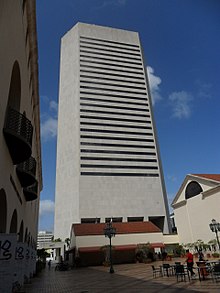
Politically, metropolitan Miami is stronglyDemocratic,like most large metropolitan regions in the United States.Broward Countyis the second-most heavily Democratic county in the state,[73][74]behind onlyGadsden County,which is much smaller. This contrasts with most of the rest of Florida, whose heavier Southern influence and high population of elderly voters makes it aswingorRepublican-leaning state.Miami-Dade Countyhas a relatively high percentage of Republican voters for an urban county, due partially to itsCuban-Americanpopulation, which leans Republican as a result of its anti-communist views, but Miami-Dade County still remains very Democratic when compared with most ofFlorida's other counties.[75][76][77]Despite being more suburban and affluent,Palm Beach Countyis reliably Democratic as well and in the 2020 presidential election voted for Democratic candidateJoe Bidenby a higher margin than Miami-Dade County did.
In the 2016 presidential election, 62.3% of voters in the Miami metropolitan area voted Democratic. This was the 6th highest of any metro area in the United States.[78]However, in recent years the area has shifted hard to the Republicans, with former president Donald Trump losing the metro area by 16 points in2020compared to losing it by 30 in 2016 (Fueled especially by Miami Dade County shifting 22 points to the right between 2016 and 2020), and GovernorRon DeSantiswinning the metro area outright in the2022 gubernatorial election,winning both Miami Dade and Palm Beach Counties (With the former being won by double digits) while losing Broward only by less than 16 points.
Government
[edit]The metropolitan area is governed by 3 counties. In total there are 107 municipalities or incorporated places in the metropolis. Each one of the municipalities has its own city, town or village government, although there is no distinction between the 3 names. Much of the land in the metropolis is unincorporated, which means it does not belong to any municipality, and therefore is governed directly by the county it is located in.
Congressional districts
[edit]The Miami metropolitan area contains all or part of nine Congressional districts: the18th,20th,21st,22nd,23rd,24th,25th,26th,and27th districts.[79]As of 2017[update](the 113th Congress), theCook Partisan Voting Indexlisted four as being Republican-leaning: the 18th, 25th, 26th, and 27th, with the 25th being the most Republican-leaning at R+5, and five as being Democratic-leaning: the 20th, 21st, 22nd, 23rd, and 24th, with the 24th being the most Democratic-leaning at D+34, making it the ninth-most Democratic-leaning district in the nation.[80]
Economy
[edit]
| GDP (billion US$) | |
|---|---|
| Miami-Dade County | 219.746[81] |
| Broward County | 146.735[82] |
| Palm Beach County | 117.543[83] |
| Miami-Fort Lauderdale-West Palm Beach, FL (MSA) | 483.755[84] |
Among those employed in the Miami metropolitan area, 32% were management, professional, and related occupations, 30% were sales and office occupations, 18% were service occupations, 11% were construction, extraction, maintenance and repair occupations, and 9% were production, transportation, and material moving occupations. 81% of the people employed were Private wage and salary workers; 12% were Federal, state, or local government workers; and 7% were self-employed.
Themedian incomeof households in the Miami area was $43,091. 78% of the households received earnings and 13% received retirement income other than Social Security. 30% of the households received Social Security. The average income from Social Security was $13[citation needed].These income sources are not mutually exclusive; that is, some households received income from more than one source.
In 2005, for the employed population 16 years and older, the leading industries in the Miami area were educational services, health care, and social assistance, which accounted for 18%, and Professional, scientific, and management, and administrative and waste management services, which accounted for 13% of the population. 79% of Miami area workers drove to work alone in 2005, 10% carpooled, 4% took public transportation, and 4% used other means. The remaining 3% worked at home. Among those who commuted to work, it took them on average 28.5 minutes to get to work.
Culture
[edit]Miami dialect
[edit]InMiami-Dade Countya unique dialect, commonly called the Miami dialect, is widely spoken. The dialect developed among second- or third-generationHispanics,includingCuban-Americans,whose first language wasEnglish,though somenon-Hispanic white,black,andother raceswho were born and raised in Miami-Dade tend to adopt it as well.[85]It is based on a fairlystandard American accentbut with some changes very similar to dialects in theMid-Atlantic,especially theNew York area dialect,Northern New Jersey English,andNew York Latino English.UnlikeVirginia Piedmont,Coastal Southern American, and Northeast American dialects and Florida Cracker dialect of the Miami accent isrhotic;it also incorporates a rhythm and pronunciation heavily influenced bySpanishin which rhythm issyllable-timed.[86]
It is possible to differentiate the Miami accent from a variety ofinterlanguagesspoken by second-language speakers. The Miami accent does not generally displayadditionof/ɛ/before initial consonant clusters with/s/,speakers do not confuse of/dʒ/with/j/,(e.g.,Yalewithjail), and /r/ and /rr/ are pronounced asalveolar approximant[ɹ] instead ofalveolar tap[ɾ] oralveolar trill[r] in Spanish.[87][88][89][90]
The Miami accent is much less common inBroward CountyandPalm Beach County,where the majority of the population is non-Hispanic.[citation needed]
Area codes
[edit]- 305:Miami-Dade Countyand theFlorida Keys;overlaid by786
- 786:Miami-Dade Countyand theFlorida Keys;overlays305
- 954:All ofBroward County:Fort Lauderdale,Hollywood,Coral Springs,Pompano Beach,overlaid by754
- 754:All ofBroward County:Fort Lauderdale,Hollywood,Coral Springs,Pompano Beach,overlays with954
- 561:All ofPalm Beach County:West Palm Beach,Boca Raton,Boynton Beach,Delray Beach,will be overlaid by728
- 728:All ofPalm Beach County:West Palm Beach,Boca Raton,Boynton Beach,Delray Beach,will overlay with561
Media
[edit]
Greater Miami is served by severalEnglish-languageand two majorSpanish-languagedaily newspapers.The Miami Herald,headquartered inDoral,is Miami's primary newspaper with over a million readers. It also has news bureaus inBroward County,Monroe County,andNassau, Bahamas.TheSouth Florida Sun-Sentinelcirculates primarily in Broward and southern Palm Beach counties and also has a news bureau in Havana, Cuba.The Palm Beach Postserves mainly Palm Beach County, especially the central and northern regions, and theTreasure Coast.TheBoca Raton Newspublishes five days a week and circulates in southern Palm Beach County.[91]El Nuevo Herald,a subsidiary of theMiami Herald,andDiario Las Americas,[92]are Spanish-language daily papers that circulate mainly in Miami-Dade County.La PalmaandEl Sentinelare weekly Spanish newspapers published by thePalm Beach PostandSun-Sentinel,respectively, and circulate in the same areas as their English-language counterparts.
There are several university student-run newspapers in the area, includingThe Miami Hurricaneat theUniversity of Miami,University PressatFlorida Atlantic University,PantherNOWatFlorida International University,andThe CurrentatNova Southeastern University.
Greater Miami is split into two separate television/radio markets: The Miami-Fort Lauderdale market serves Miami-Dade, Broward and the Florida Keys. The West Palm Beach market serves Palm Beach County and theTreasure Coastregion.
Miami-Fort Lauderdale is the 12th largest radio market and the 16th-largest television market in the U.S. television stations serving the Miami-Fort Lauderdale area includeWAMI-TV(UniMas),WBFS-TV(MyNetworkTV),WSFL-TV(The CW),WFOR-TV(CBS),WHFT-TV(TBN),WLTV(Univision),WPLG(ABC),WPXM(ION),WSCV(Telemundo),WSVN(FOX),WTVJ(NBC),WLRN-TV(PBS), andWPBT(also PBS), the latter television station being the only channel to serve the entire metropolitan area.
In addition to the Miami-Fort Lauderdale market, West Palm Beach has its own. It is the 49th largest radio market and the 38th-largest television market in the U.S. Television stations serving the West Palm Beach area includeWPTV(NBC),WPEC(CBS),WPBF(ABC),WFLX(FOX),WTVX(The CW),WXEL(PBS),WTCN(MyNetworkTV), andWPXP(ION). The West Palm Beach market shares use of WSCV and WLTV for Telemundo and Univision respectively. Also, both markets cross over and tend to be available interchangeably between both areas. In 2015, WPBT and WXEL merged their operations, to formSouth Florida PBS,although both stations have maintained separate programming schedules and social media platforms, but share the same subchannel lineup.
Education
[edit]

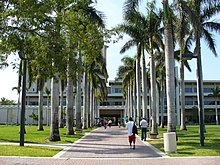

In Florida, each county is also aschool district.Each district is headed by an electedschool board.A professionalsuperintendentmanages the day-to-day operations of each district, who is appointed by and serves at the pleasure of the school board.
TheMiami-Dade County Public School Districtis currently the4th-largest public school districtin the nation. TheSchool District of Palm Beach Countyis the 4th-largest in Florida and the 11th-largest in the United States.Broward County Public School Districtis the 6th-largest in the United States.
TheUniversity of Miamiis one of the top-ranked private research institutions in the United States, and has the most selective admissions standards of Florida's 171 colleges and universities.[93]
As of 2023[update],Florida International University,with over 55,000 enrolled students, is theeighth-largest public university by enrollmentin the nation.
Some colleges and universities in Greater Miami include:
- Barry University(private/Catholic)
- Broward College(public)
- Carlos Albizu University(private)
- Chamberlain University(private)
- Florida Atlantic University(public)
- Florida International University(public)
- Florida Memorial University(private/Baptist)
- Florida National University(private)
- Jersey College(private)
- Keiser University(private)
- Lynn University(private)
- Miami Dade College(public)
- Miami International University of Art & Design(private)
- Nova Southeastern University(private)
- Palm Beach Atlantic University(private/Christian)
- Palm Beach State College(public)
- St. Thomas University(private/Catholic)
- University of Fort Lauderdale(private/Christian)
- University of Miami(private)
In 2005, 82% of people 25 years and over had at least graduated from high school and 28% had abachelor's degreeor higher. Among people 16 to 19 years old, 7% weredropouts;they were not enrolled in school and had not graduated from high school. The total school enrollment in the Miami metro area was 1.4 million in 2005. Nursery school andkindergartenenrollment was 170,000 and elementary or high school enrollment was 879,000. College or graduate school enrollment was 354,000.
Transportation
[edit]Roads
[edit]
The Miami metropolitan area is served by fiveinterstate highwaysoperated by theFlorida Department of Transportation(FDOT) in conjunction with local agencies.Interstate 95 (I-95)runs north to south along the coast, ending just south ofDowntown MiamiatSouth Dixie Highway(US 1).I-75runs east to west, turning south in western Broward County and connecting suburban north Miami-Dade toNapleson theSouthwest CoastviaAlligator Alley,which transverses the FloridaEvergladesbefore turning north.I-595connects the Broward coast and DowntownFort Lauderdaleto I-75 and Alligator Alley. In Miami,I-195andI-395relay the main I-95 route east toBiscayne Boulevard(US 1) andMiami BeachacrossBiscayne Bayvia theJulia TuttleandMacArthurcauseways.
In greater Miami, theMiami-Dade Expressway AuthorityandFlorida's Turnpike Enterprise(FTE) maintain eightstateexpressways in conjunction with FDOT. TheAirport Expressway (SR 112)and theDolphin Expressway (SR 836)relay western Miami-Dade suburbs to the eastern urban coast at I-95, and to Miami Beach via I-195 and I-395 at the Airport andMidtowninterchanges.TheGratigny Parkway (SR 924)connects northern Miami suburbs to the southern end of I-75. ThePalmetto Expressway (SR 826)is the primarybeltway roadof urban Miami, relaying I-95 andFlorida's Turnpike(SR 91) at theGolden Glades Interchangenear northeasternNorth Miami Beachto the southern inland suburbs ofKendallandPinecrest.TheDon Shula Expressway (SR 874)and theHomestead Extension of Florida's Turnpike(SR 821) form the southernmost end of the beltway, connecting the Palmetto Expressway to thebedroom communitiesofHomesteadandFlorida City.TheSnapper Creek Expressway (SR 878)relays the Don Shula Expressway to South Dixie Highway (US 1).
The urbanbypassexpressway in greater Fort Lauderdale is theSawgrass Expressway (SR 869),connecting the northern Broward County coast at I-95 andDeerfield Beachto I-595 and I-75 at Alligator Alley inSunrise.
Express lanes on I-95 start inMiami-Dade Countyand continue intoBroward County.With an increased presence of traffic in South Florida, express lanes have been implemented in southernPalm Beach County.
Major freeways and tollways
[edit] Interstate 95
Interstate 95 Interstate 75
Interstate 75 Interstate 195/
Interstate 195/ State Road 112(Airport Expressway)
State Road 112(Airport Expressway) Interstate 395/
Interstate 395/ State Road 836(Dolphin Expressway)
State Road 836(Dolphin Expressway) Interstate 595(Port Everglades Expressway)
Interstate 595(Port Everglades Expressway) Florida's Turnpike,includingHomestead Extension
Florida's Turnpike,includingHomestead Extension State Road 924(Gratigny Parkway)
State Road 924(Gratigny Parkway) State Road 874(Don Shula Expressway)
State Road 874(Don Shula Expressway) State Road 878(Snapper Creek Expressway)
State Road 878(Snapper Creek Expressway) State Road 869(Sawgrass Expressway)
State Road 869(Sawgrass Expressway) State Road 826(Palmetto Expressway)
State Road 826(Palmetto Expressway)
Major airports
[edit]The metropolitan area is served by three major commercial airports. These airports combine to make the fourth largest domestic origin and destination market in the United States, after New York City, Los Angeles, and Chicago.[94]
| Airport | IATA code | County | FAA Category |
|---|---|---|---|
| Miami International Airport | MIA | Miami-Dade | Large Hub |
| Fort Lauderdale–Hollywood International Airport | FLL | Broward | Large Hub |
| Palm Beach International Airport | PBI | Palm Beach | Medium Hub |
The following smaller general aviation airports are also in the metro area:
| Airport | IATA code | ICAO code | County |
|---|---|---|---|
| Dade-Collier Training and Transition Airport | TNT | KTNT | Miami-Dade |
| Miami Homestead General Aviation Airport | Miami-Dade | ||
| Homestead Joint Air Reserve Base | HST | KHST | Miami-Dade |
| Miami Executive Airport | TMB | KTMB | Miami-Dade |
| Miami-Opa Locka Executive Airport | OPF | KOPF | Miami-Dade |
| Fort Lauderdale Executive Airport | FXE | KFXE | Broward |
| North Perry Airport | HWO | KHWO | Broward |
| Pompano Beach Airpark | PPM | KPMP | Broward |
| North Palm Beach County General Aviation Airport | Palm Beach | ||
| Palm Beach County Park Airport | LNA | KLNA | Palm Beach |
| Boca Raton Airport | BCT | KBCT | Palm Beach |
Seaports
[edit]
The metropolis also has four seaports, the largest and most important being thePort of Miami.Others in the area includePort Everglades,Port of Palm Beachand theMiami RiverPort. On August 21, 2012, PortMiami and the U.S. Army Corps of Engineers signed the Partnership Agreement (PPA) construction agreement that will allow the Deep Dredge project to go out for bid. The Deep Dredge will deepen the Port's existing channels to minus 50/52 feet to prepare for the Panama Canal expansion, now scheduled for completion in early 2015. PortMiami's deeper channel will provide ships with an economically efficient, reliable and safe navigational route into the Port. PortMiami will be the only U.S. Port south of Norfolk, Virginia to be at the minus 50 foot depth in sync with the opening of the expanded Canal. Deep Dredge is expected to create more than 30,000 direct, indirect, and induced jobs in Florida and allow the Port to meet its goal to double its cargo traffic over the next decade.
Public transportation
[edit]Miami-Dade Transit(MDT) is the largest public transit agency in Florida, operatingrapid transit,people movers,and anintercity bussystem. Metrorail is Florida's onlyrapid transit,currently with 23 stations on a 24.4-mile (39.3 km) track. TheDowntown Miamipeople mover,Metromover, operates 20 stations and three lines on a 4.4-mile (7.1 km) track through the Downtownneighborhoodsof theArts & Entertainment District,theCentral Business District,andBrickell.Metrobus serves the entirety of Miami-Dade County, also servingMonroe Countyas far south asMarathon,andBroward Countyas far north as Downtown Fort Lauderdale. In Broward County,Broward County Transitruns public buses, as doesPalm Tranin Palm Beach County. Additionally, theSouth Florida Regional Transportation Authorityoperates Tri-Rail, a commuter rail train that connects the three of the primary cities of South Florida (Miami, Fort Lauderdale, and West Palm Beach), and most intermediate points.Brightlineprovides service toMiami,Aventura,West Palm Beach,Fort Lauderdale,Boca Raton,and Central Florida'sOrlando,with talks to expand toTampaandJacksonville.[95][96]
Sports
[edit]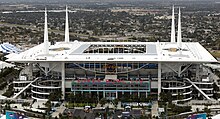
Professional
[edit]The Miami metro area is home to five major league professional sports teams.
| Professional team | League | Sport | Venue | City | Established | Championships |
|---|---|---|---|---|---|---|
| Miami Dolphins | National Football League(NFL) | Football | Hard Rock Stadium | Miami Gardens | 1966 | 2 |
| Inter Miami CF | Major League Soccer(MLS) | Soccer | Chase Stadium | Fort Lauderdale | 2020 | 1 |
| Miami Heat | National Basketball Association( NBA ) | Basketball | Miami-Dade Arena | Downtown Miami | 1988 | 3 |
| Miami Marlins | Major League Baseball(MLB) | Baseball | Marlins Park | Little Havana | 1993 | 2 |
| Florida Panthers | National Hockey League(NHL) | Hockey | Amerant Bank Arena | Sunrise | 1993 | 1 |
College sports
[edit]The most prominent college sports program in the Miami metropolitan area are theMiami Hurricanesof theUniversity of MiamiinCoral Gables,who compete inDivision Iof theNational Collegiate Athletic Association,the highest level of collegiate athletics.[97]The University of Miami'sfootball teamhas won five national championships since 1983 and itsbaseball teamhas won four national championships since 1982.
Other collegiate sports programs in the metropolitan area include theFlorida Atlantic OwlsofFlorida Atlantic UniversityinBoca Raton,theFIU PanthersofFlorida International UniversityinUniversity Park,theNova Southeastern SharksofNova Southeastern UniversityinDavie,and theBarry BuccaneersofBarry UniversityinMiami Shores.
Minor league and other sports
[edit]The Miami area is also host to minor league sports teams, including:
- TheMiami MarlinsandSt. Louis Cardinalsconductspring traininginJupiteratRoger Dean Stadium.
- TheHouston AstrosandWashington Nationalsconductspring traininginWest Palm BeachatThe Ballpark of the Palm Beaches.[98][99][100]
- Inter Miami CFwill have areserve teamthat will play inUSL League One.
- TheHomestead-Miami Speedwayoval has hostedNASCAR Cup SeriesandIndyCar Seriesevents. Temporarystreet circuitsatMuseum Parkhosted severalCART,IMSA GT,andAmerican Le Mans Seriesraces between from 1986 to 1995, as well as aFormula E race in 2015.ThePalm Beach International Racewayis a minor road course.
| Club | Sport | League | Venue (Capacity) | Attendance | League Championships |
|---|---|---|---|---|---|
| Miami Dolphins | Football | National Football League | Hard Rock Stadium(64,767) | 70,035 | Super Bowl(2) — 1972, 1973 |
| Miami Heat | Basketball | National Basketball Association | Kaseya Center(19,600) | 19,710 | NBA Finals(3) — 2006, 2012, 2013 |
| Miami Marlins | Baseball | Major League Baseball | LoanDepot Park(36,742) | 21,386 | World Series(2) — 1997, 2003 |
| Inter Miami CF | Soccer | Major League Soccer | Chase Stadium | 21,550 | |
| Florida Panthers | Hockey | National Hockey League | FLA Live Arena(19,250) | 10,250 | Stanley Cup(1) — 2024 |
| Miami Hurricanes | Football | NCAA D-I(ACC) | Hard Rock Stadium(64,767) | 53,837 | National titles (5) — 1983, 1987, 1989, 1991, 2001 |
| Florida Atlantic Owls | Football | NCAA D-1(AAC) | FAU Stadium(29,571) | 18,948 | None |
| FIU Panthers | Football | NCAA D-I(Conference USA) | FIU Stadium(23,500) | 15,453 | None |
-
FLA Live Arena,home of theFlorida Panthers
-
FAU Stadium,home of theFlorida Atlantic Owls
-
Riccardo Silva Stadium,home of theFIU Panthers
See also
[edit]- South Florida
- United States metropolitan area
- Table of United States Metropolitan Statistical Areas
- Largest metropolitan areas in the Americas
Notes
[edit]- ^Mean monthly maxima and minima (i.e. the highest and lowest temperature readings during an entire month or year) calculated based on data at said location from 1991 to 2020.
- ^Official records for Miami were kept at theLemon Cityfrom September 1895 to November 1900, the MiamiCOOPfrom December 1900 to May 1911, the Weather Bureau Office from June 1911 to February 1937, at various locations in and around the city from March 1937 to July 1942, and at Miami Int'l since August 1942. For more information, seeThreadEx.
- ^Language spoken at home among residents at least five years old; only languages (or language groups) which at least 2% of residents have spoken at any time since 1980 are mentioned
- ^Refers to 2013–2017American Community Surveydata;[56]the last Decennial Census where language data was collected was in the2000 census
- ^Refers to 2008–2012American Community Surveydata;[57]the last Decennial Census where language data was collected was in the2000 census
- ^Refers to 2013–2017American Community Surveydata;[61][62]the last Decennial Census where foreign-born population data was collected was in the2000 census
- ^Refers to 2008–2012American Community Surveydata;[63][64]the last Decennial Census where foreign-born population data was collected was in the2000 census
- ^Only countries of birth which at least 0.2% of residents were born in at any time since 1980 are mentioned
- ^abcdefghijklmnopqNot counted separately; aggregated into "Other" category
- ^abData from the 1980 census and 1990 census pertains to residents born anywhere in theSoviet Union,not just Russia
References
[edit]- ^abcd"Revised Delineations of Metropolitan Statistical Areas, Micropolitan Statistical Areas, and Guidance on the Uses of the Delineations of These Areas"(PDF).Executive Office of the President.July 21, 2023. p. 62.RetrievedJuly 21,2023.
- ^abc"P2: HISPANIC OR LATINO, AND NOT... - Census Bureau Table".P2 | HISPANIC OR LATINO, AND NOT HISPANIC OR LATINO BY RACE.U.S. Census Bureau.RetrievedJune 8,2023.
- ^abc"County Population Totals and Components of Change: 2020-2023".County Population Totals: 2020-2023.U.S. Census Bureau. March 30, 2023.RetrievedMarch 22,2024.
- ^"Total Gross Domestic Product for Miami-Fort Lauderdale-West Palm Beach, FL (MSA)".Federal Reserve Economic Data.Federal Reserve Bank of St. Louis.
- ^PDFMiami-Fort Lauderdale-Pompano Beach: Linear & Visionless– retrieved August 2, 2006
- ^USA Urbanized Areas Over 500,000: 2000 Rankings – Rank by Density– URL retrieved September 5, 2006
- ^"2020 Census ua list all (spreadsheet)".U.S. Census Bureau.RetrievedFebruary 23,2024.
- ^Lists of Census 2000 Urbanized Areas and Urban ClustersArchivedJune 13, 2002, at theWayback Machine– URL retrieved August 27, 2006
- ^NOTE: large (2.8 MB)PDFfile –UMiami, Florida Urbanized Area Outline Map, 2000 Census– URL retrieved August 27, 2006
- ^"The NCES Fast Facts Tool provides quick answers to many education questions (National Center for Education Statistics)".
- ^ab"Florida Population: Census Summary 2020"(PDF).University of Florida Bureau of Economic and Business Research.2021. pp. 27–29.RetrievedMay 21,2023.
- ^"List II - Consolidated Metropolitan Statistical Areas and Primary Metropolitan Statistical Areas"(PDF).White House Office of Management and Budget.June 30, 1995. Archived fromthe original(PDF)on August 9, 2017.RetrievedMay 23,2023.
- ^"OMB Bulletin No. 03-04 - Attachment"(PDF).White House Office of Management and Budget.June 6, 2003. p. 39. Archived fromthe original(PDF)on August 9, 2017.RetrievedMay 22,2023.
- ^ab"Revised Delineations of Metropolitan Statistical Areas, Micropolitan Statistical Areas, and Guidance on the Uses of the Delineations of These Areas"(PDF).Executive Office of the President.July 21, 2023. p. 138.RetrievedJuly 21,2023.
- ^"OMB Bulletin No. 13-1: Revised Delineations of Metropolitan Statistical Areas, Micropolitan Statistical Areas, and Combined Statistical Areas, and Guidance on Uses of the Delineations of These Areas"(PDF).U.S. Bureau of Labor Statistics.February 28, 2013.RetrievedFebruary 28,2023.
- ^"OMB Bulletin No. 18-04 - Revised Delineations of Metropolitan Statistical Areas, Micropolitan Statistical Areas, and Combined Statistical Areas, and Guidance in the Uses of These Areas"(PDF).White House Office of Management and Budget.September 14, 2018.RetrievedMay 23,2023.
- ^Lamme, Ary J.; Oldakowski, Raymond K. (November 2007). "Spinning a New Geography of Vernacular Regional Identity: Florida in the Twenty-First Century".Southeastern Geographer.47(2): 330–331.doi:10.1353/sgo.2007.0029.S2CID129577530.
- ^"2020 U.S. Census data".
- ^"Köppen Climate Classification Map: South Florida=Aw=tropical wet & dry".Archived fromthe originalon July 6, 2011.
- ^Climate Zones of the World, under Koppen's System.Retrieved August 8, 2006.
- ^Weather Vulnerable cities: Miami, FloridaArchivedApril 27, 2006, at theWayback Machine.Retrieved February 19, 2006.
- ^Mean monthly maxima and minima (i.e. the highest and lowest temperature readings during an entire month or year) calculated based on data at said location from 1981 to 2010.
- ^"NOWData - NOAA Online Weather Data".National Oceanic and Atmospheric Administration.RetrievedAugust 21,2012.
- ^"Station Name: FL WEST PALM BEACH INTL AP".National Oceanic and Atmospheric Administration.RetrievedApril 13,2018.
- ^Minas, Isabella."Best Times to Visit Ft Lauderdale".travel.usnews.USNews.RetrievedAugust 23,2018.
- ^Torres, Javier."Climate Fort Lauderdale, FL".usclimatedata.US Climate Data.RetrievedAugust 24,2018.
- ^Henthorn, Dawn."Avg Monthly Temps & Rainfall in Fort Lauderdale, FL".tripsavvy.RetrievedAugust 22,2018.
- ^ab"NOWData – NOAA Online Weather Data".National Oceanic and Atmospheric Administration.RetrievedMay 9,2021.
- ^"Summary of Monthly Normals 1991–2020".National Oceanic and Atmospheric Administration.RetrievedMay 9,2021.
- ^"WMO Climate Normals for Miami, FL 1961–1990".National Oceanic and Atmospheric Administration.RetrievedJuly 18,2020.
- ^"Monthly Averages for Miami International Airport".The Weather Channel.RetrievedOctober 12,2013.
- ^"Historical UV Index Data - Miami, FL".UV Index Today.RetrievedApril 21,2023.
- ^"Number Days with Thunder".UNdata.RetrievedJune 19,2023.
- ^Census Bureau – About Metropolitan and Micropolitan Statistical AreasArchivedApril 1, 2013, at theWayback Machine– retrieved Dec. 19, 2013
- ^Census Bureau Geographic Terms and Concepts – Core Based Statistical Areas and Related Statistical Areas– retrieved Dec. 19, 2013
- ^Metropolitan and micropolitan statistical areas defined by the Office of Management and Budget, December 2009– retrieved July 22, 2011
- ^"Census Counts: 1830-2020".Florida County Population Census Counts: 1830 to 2020.Office of Economic and Demographic Research, The Florida Legislature. 2023.Archivedfrom the original on April 4, 2022.RetrievedJune 8,2023.
- ^abc"General Population Characteristics FLORIDA 1980 Census of Population"(PDF).07553445v1chA-Cpt11sec1ch002.pdf.U.S. Census Bureau.RetrievedJune 8,2023.
- ^abc"1990 Census of Population General Population Characteristics Florida Section 1 of 2"(PDF).Florida: 1990, Part 1.U.S. Census Bureau.RetrievedJune 8,2023.
- ^ab"PL002: HISPANIC OR LATINO, AND NOT... - Census Bureau Table".PL002 | HISPANIC OR LATINO, AND NOT HISPANIC OR LATINO BY RACE [73].U.S. Census Bureau.RetrievedJune 8,2023.
- ^ab"P2: HISPANIC OR LATINO, AND NOT... - Census Bureau Table".P2 | HISPANIC OR LATINO, AND NOT HISPANIC OR LATINO BY RACE.U.S. Census Bureau.RetrievedMarch 22,2024.
- ^"H1 | OCCUPANCY STATUS".H1: OCCUPANCY STATUS - Census Bureau Table.U.S. Census Bureau.RetrievedJune 9,2023.
- ^"P12 | SEX BY AGE FOR SELECTED AGE CATEGORIES".P12: SEX BY AGE FOR SELECTED... - Census Bureau Table.U.S. Census Bureau.RetrievedJune 9,2023.
- ^"P13 | MEDIAN AGE BY SEX".P13: MEDIAN AGE BY SEX - Census Bureau Table.U.S. Census Bureau.RetrievedJune 9,2023.
- ^"H1 | OCCUPANCY STATUS".H1: OCCUPANCY STATUS - Census Bureau Table.U.S. Census Bureau.RetrievedJune 9,2023.
- ^"P12 | SEX BY AGE".P12: SEX BY AGE - Census Bureau Table.U.S. Census Bureau.RetrievedJune 9,2023.
- ^"P13 | MEDIAN AGE BY SEX".P13: MEDIAN AGE BY SEX - Census Bureau Table.U.S. Census Bureau.RetrievedJune 9,2023.
- ^"H003 | OCCUPANCY STATUS [3]".H003: OCCUPANCY STATUS [3] - Census Bureau Table.U.S. Census Bureau.RetrievedJune 9,2023.
- ^"P012 | SEX BY AGE [49]".P012: SEX BY AGE [49] - Census Bureau Table.U.S. Census Bureau.RetrievedJune 9,2023.
- ^"P013 | MEDIAN AGE BY SEX [3]".P13: MEDIAN AGE BY SEX [3] - Census Bureau Table.U.S. Census Bureau.RetrievedJune 9,2023.
- ^"General Population Characteristics FLORIDA 1980 Census of Population"(PDF).07553445v1chA-Cpt11sec1ch002.pdf.U.S. Census Bureau.RetrievedApril 13,2023.
- ^"S2001: EARNINGS IN THE PAST 12... - Census Bureau Table".S2001 | EARNINGS IN THE PAST 12 MONTHS (IN 2021 INFLATION-ADJUSTED DOLLARS).U.S. Census Bureau.RetrievedJune 9,2023.
- ^"S1901: INCOME IN THE PAST 12 MONTHS... - Census Bureau Table".S1901 | INCOME IN THE PAST 12 MONTHS (IN 2021 INFLATION-ADJUSTED DOLLARS).U.S. Census Bureau.RetrievedJune 9,2023.
- ^"S1701: POVERTY STATUS IN THE PAST... - Census Bureau Table".S1701 | POVERTY STATUS IN THE PAST 12 MONTHS.U.S. Census Bureau.RetrievedJune 9,2023.
- ^abc"S1501: EDUCATIONAL ATTAINMENT - Census Bureau Table".S1501 | EDUCATIONAL ATTAINMENT.U.S. Census Bureau.RetrievedJune 9,2023.
- ^"C16001: LANGUAGE SPOKEN AT HOME FOR... - Census Bureau Table".C16001 | LANGUAGE SPOKEN AT HOME FOR THE POPULATION 5 YEARS AND OVER.U.S. Census Bureau.RetrievedJune 9,2023.
- ^"B16001: LANGUAGE SPOKEN AT HOME BY - Census Bureau Table".B16001 | LANGUAGE SPOKEN AT HOME BY ABILITY TO SPEAK ENGLISH FOR THE POPULATION 5 YEARS AND OVER.U.S. Census Bureau.RetrievedJune 9,2023.
- ^"PCT010: AGE BY LANGUAGE SPOKEN AT... - Census Bureau Table".PCT010 | AGE BY LANGUAGE SPOKEN AT HOME FOR THE POPULATION 5 YEARS AND OVER [83].U.S. Census Bureau.RetrievedJune 9,2023.
- ^ab"1990 Census of Population General Social and Economic Characteristics Florida Section 1 of 3"(PDF).Florida: 1990, Part 1.U.S. Census Bureau.RetrievedJune 9,2023.
- ^ab"General Social and Economic Characteristics FLORIDA 1980 Census of Population"(PDF).U.S. Census Bureau.RetrievedJune 9,2023.
- ^"B05001: NATIVITY AND CITIZENSHIP... - Census Bureau Table".B05001 | NATIVITY AND CITIZENSHIP STATUS IN THE UNITED STATES.U.S. Census Bureau.RetrievedJune 9,2023.
- ^"B05006: PLACE OF BIRTH FOR THE... - Census Bureau Table".B05006 | PLACE OF BIRTH FOR THE FOREIGN-BORN POPULATION IN THE UNITED STATES.U.S. Census Bureau.RetrievedJune 9,2023.
- ^"B05001: NATIVITY AND CITIZENSHIP... - Census Bureau Table".B05001 | NATIVITY AND CITIZENSHIP STATUS IN THE UNITED STATES.U.S. Census Bureau.RetrievedJune 9,2023.
- ^"B05006: PLACE OF BIRTH FOR THE... - Census Bureau Table".B05006 | PLACE OF BIRTH FOR THE FOREIGN-BORN POPULATION IN THE UNITED STATES.U.S. Census Bureau.RetrievedJune 9,2023.
- ^"P021: PLACE OF BIRTH BY CITIZENSHIP... - Census Bureau Table".P021 | PLACE OF BIRTH BY CITIZENSHIP STATUS [15].U.S. Census Bureau.RetrievedJune 9,2023.
- ^"PCT019: PLACE OF BIRTH FOR THE... - Census Bureau Table".PCT019 | PLACE OF BIRTH FOR THE FOREIGN-BORN POPULATION [126].U.S. Census Bureau.RetrievedJune 9,2023.
- ^"Adults in the Miami metro area".Pew Research Center.
- ^Major U.S. metropolitan areas differ in their religious profiles,Pew Research Center
- ^"America's Changing Religious Landscape".Pew Research Center:Religion & Public Life. May 12, 2015.
- ^"Greater Miami Jewish Federation Releases New Study on Miami Jewish Population".Greater Miami Jewish Federation.RetrievedJune 5,2020.
- ^Comenetz, Joshua."Jewish Maps of the United States by Counties, 2011".Berman Jewish DataBank.RetrievedSeptember 10,2017.
- ^Hanks, Douglas (October 29, 2010)."Housing costs higher in South Florida".The Miami Herald.RetrievedFebruary 22,2011.
- ^State:Broward Power.St. Petersburg Times.Retrieved November 14, 2006.
- ^2008 General Election ResultsArchivedOctober 11, 2012, at theWayback Machine.South Florida Sun-Sentinel.Retrieved November 11, 2008.
- ^"South Florida Sun-Sentinel Election 2008 (Florida Presidential election results): 2008".Sun-sentinel. Archived fromthe originalon December 2, 2011.RetrievedNovember 8,2011.
- ^"Election 2004 (Florida Presidential election results): 2004".CNN. April 13, 1970.RetrievedNovember 8,2011.
- ^"Election 2006 (Florida Gubernatorial election results): 2006".CNN.RetrievedNovember 8,2011.
- ^"Mapping How America's Metro Areas Voted".CityLab. December 1, 2016.RetrievedApril 13,2017.
- ^"Congressional Districts – Florida" (Map).National Atlas of the United States(PDF).Cartography by USGS.United States Geological Survey.2013. Archived fromthe original(PDF)on September 4, 2014.RetrievedAugust 17,2014.
- ^"Partisan Voting Index Districts of the 113th Congress"(PDF).The Cook Political Report.Archived fromthe original(PDF)on July 29, 2017.RetrievedFebruary 20,2019.
- ^"Gross Domestic Product: All Industries in Miami-Dade County, FL".Federal Reserve Economic Data.Federal Reserve Bank of St. Louis.
- ^"Gross Domestic Product: All Industries in Broward County, FL".fred.stlouisfed.org.
- ^"Gross Domestic Product: All Industries in Palm Beach County, FL".fred.stlouisfed.org.
- ^"Total Gross Domestic Product for Miami-Fort Lauderdale-West Palm Beach, FL (MSA)".fred.stlouisfed.org.
- ^"Miami Accents: Why Locals Embrace That Heavy" L "Or Not".WLRN (WLRN-TVandWLRN-FM). August 27, 2013.RetrievedSeptember 1,2013.
- ^"'Miami Accent' Takes Speakers By Surprise ".Articles –Sun-Sentinel.June 13, 2004. Archived fromthe originalon August 20, 2012.RetrievedOctober 8,2012.
- ^"Miami Accents: How 'Miamah' Turned Into A Different Sort Of Twang".WLRN (WLRN-TV&WLRN-FM). August 26, 2013.RetrievedSeptember 1,2013.
- ^Haggin, Patience (August 27, 2013)."Miami Accents: Why Locals Embrace That Heavy" L "Or Not".
- ^Watts, Gabriella (August 26, 2013)."Miami Accents: How 'Miamah' Turned Into A Different Sort Of Twang".
- ^"English in the 305 has its own distinct Miami sound".Miami Herald.Archived fromthe originalon December 3, 2013.RetrievedSeptember 10,2013.
- ^Boca Raton News home pageArchivedMay 17, 2013, at theWayback Machine– URL retrieved August 19, 2006
- ^"Diario Las Americas".Diario Las Americas. August 2, 2010.RetrievedNovember 8,2011.
- ^University of MiamiArchivedJuly 11, 2022, at theWayback Machineat Niche
- ^"Top 200 U.S. Airports Ranked By Domestic O&D Traffic, Year Ended March 2007"(PDF).eclatconsulting.Archived fromthe original(PDF)on April 8, 2008.
- ^Davis, Ennis."Virgin Trains expands in Florida. Will it ever reach Jacksonville?".Sarasota Herald-Tribune.RetrievedJune 5,2020.
- ^Newspapers, Joshua Solomon, Treasure Coast."Virgin Trains OKs 3 new stations in South Florida, so when will it build stations here?".The Palm Beach Post.RetrievedJune 5,2020.
{{cite web}}:CS1 maint: multiple names: authors list (link) - ^"Miami (Florida)".National Collegiate Athletic Association. Archived fromthe originalon November 13, 2013.RetrievedFebruary 7,2010.
- ^"New first name for Ballpark of the Palm Beaches: Fitteam".Archived fromthe originalon February 20, 2018.RetrievedFebruary 20,2018.
- ^Janes, Chelsea (February 16, 2018)."Nationals and Astros reach naming rights deal for Ballpark of the Palm Beaches"– via washingtonpost.
- ^"Astros, Nats rename FITTEAM Ballpark".MLB.







